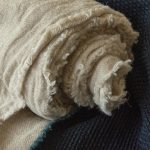Natural Dyeing : Keeping a Dye Journal
There are so many similarities between natural dyeing and cooking. Just like every chef has their way of cooking, whether it’s by exact measurements or eyeballing, natural dyers have their own way of following recipes and creating colours with many ways to get to the same result. In the same way that some of us like to follow recipes and others don’t, your creative process will often reflect your personality type. So much of natural dyeing is about intuition, spontaneity & experimentation. Like anything, the more you experiment, the more you will come to know and rely on your accumulated knowledge to create the colours that you are drawn to.
There is no right or wrong way to natural dye, whichever way makes sense for you and works with your personality type is the right way for you. No matter what your way of doing things I always encourage novice dyers to test everything before committing to a large piece of fabric or clothing and to also keep a dye journal. This way you can record how you achieve certain colours with swatches for colour reference.
There are many factors that will come into your process and if you don’t write them down and end up with a beautiful colour, it might be hard to remember how you achieved that result. When I am dyeing, I record the following: the date/season, many dyes will give you different variations of colour depending on the time of the year, what you may yield from a plant in Summer will often be different in the Spring. The type and weight of the fabric, if it is mordanted, what it was mordanted with. The plant or plant part you are using, the amount/weight of dye stuff ( this is where a weighing scale comes in handy). I like to keep a track of how long I simmer the dye before the dye is released and I add the fabric. Then I keep a note of how long the dye was in the pot to achieve the resulting colour and finally how the pieces were washed.
At first, it can be a hard practice to incorporate, just like with cooking a meal, there’s so much going on and it is easy to get lost in the process. Losing yourself in a creative endeavour is a beautiful thing and a huge part of natural dyeing. You can still lose yourself, just scribble some notes down as you go. It took me a long time to incorporate this into my practice but now I make sure to keep notes as I go and staple a small swatch next to my notes. Although I understand this is not for everyone, if you are looking to reproduce colours in the future it will be much easier if you keep track of what you previously did. The colours you create have recipes to accompany them and these become yours to tweak, develop, and learn from.





















































One Comment
Dorota Gil
Hello Kathryn,
you got me hooked. I’m planning on starting my natural dying adventures. I’ll start simple with yellows from daffodils and pinks from avocado. However I’m wondering how one might achieve grey color? Can I see right that you got something like grey with a mix of tea+indigo and then iron to darken it? Thank you for any poinetrs :).